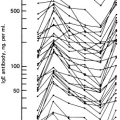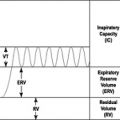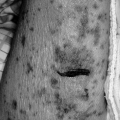Approach to the Patient with Pruritus
David C. Reid
Anne E. Laumann
Introduction
Pruritus, or itching, is a common, complex, and often debilitating sensation that, if sufficiently strong, will provoke either conscious or reflex scratching, or the desire to scratch. The word, pruritus, originates from the Latin prurire (to itch). The suffix “itus” is not to be confused with the Greek-derived “itis,” meaning “inflammation of.” While the temporary discomfort of itch, such as that which develops after an insect bite, is common, pruritus that is generalized, severe, or persistent can be an incapacitating symptom and a sign of internal disease.
Itching is the most common dermatologic symptom. When it is symptomatic of a visible skin problem, the etiology may be discerned from physical examination and/or biopsy. Pruritus in the absence of cutaneous findings, however, is a diagnostic challenge, and effective therapy may be elusive. This chapter begins with an overview of pruritus, and then discusses the investigation and management of the individual with itching in the absence of visible skin disease.
Classification
There is no universally accepted classification of pruritus, and nomenclature is variable. Generally, itching is described as “cutaneous” (due to skin disease) or essential (lacking skin findings). It may also be distinguished based on source: dermatologic or pruritoceptive (originating in the skin due to localized irritation), systemic (arising from pathology in internal organs), neurogenic/neuropathic (due to diseases of the central or peripheral nervous system), and psychogenic (due to psychiatric disease).
In 2007, the International Forum for the Study of Itch formed a clinically based classification of pruritic diseases (1):
Pruritus on diseased (inflamed) skin
Pruritus on nondiseased (noninflamed) skin
Pruritus with severe secondarily scratched lesions
This chapter focuses on group II. It is important to note, however, that the presence of skin findings does not exclude an underlying systemic cause, and the absence of rash does not equate with systemic disease.
Pathophysiology
It was long thought that nociceptors in the skin mediate both pruritus (through weak activation) and pain (through stronger activation), but more recent evidence suggests that specific receptors and nerves selectively signal itch. The triggering sensation is transmitted by a functionally distinct subset of afferent, unmyelinated C-fibers (2). These neurons respond to histamine, interleukin-2, μ- and κ-opioid system changes, and substance P (3). They are insensitive to mechanical stimuli. Different receptors may be responsible for itching resulting from electrical stimuli or friction. After reaching dorsal horn neurons in the spinal cord, the stimulus travels to the thalamus and cerebral cortex, producing the itch sensation and, through activation of the motor cortex, the desire to scratch.
Etiology
Itching without skin lesions can be due to underlying systemic disease, stem from neurologic or psychologic disorders, or result from pharmacologic therapy. Ten to fifty percent of patients with pruritus have an underlying systemic disease, chronic renal disease, cholestasis, hematologic malignancies, thyroid dysfunction, HIV infection, and carcinoid syndrome being the most common (4).
History
A detailed history is essential. In the absence of visible skin disease, temporal associations, environmental factors, and systemic symptoms are important pointers. No particular clinical characteristic helps define the
probability of an underlying disease, but some predication can be made from the summation of features. Sometimes multiple office visits and review of patient self-kept journals are necessary.
probability of an underlying disease, but some predication can be made from the summation of features. Sometimes multiple office visits and review of patient self-kept journals are necessary.
Leading questions are suggested in Table 32.1. Abrupt onset of severe itching is uncommon for systemic disease, which usually presents insidiously. Systemic diseases often produce generalized, symmetric itching, whereas a localized distribution suggests a neuropathic etiology, such as brachioradial pruritus (5), or notalgia paresthetica. Prior to direct questioning, the patient may not realize that the itching occurs at specific times of day or related to particular activities, such as bathing or exercise. Most itching is more problematic at night so this diurnal variation is of limited diagnostic value.
Table 32.1 Historical Questions for the Pruritic Patient | |
|---|---|
|
The feeling of insects crawling or biting under the skin is called formication, and may be a symptom of depression, but the presence of a psychologically localized, fixed, and immutable belief that the discomfort stems from parasitic infestation, despite a lack of objective evidence, portends the condition, delusions of parasitosis. A tell-tale sign is the appearance in the doctor’s office of small bags or boxes of lint, skin flakes, and textile fibers for microscopic examination. Delusions of parasitosis is related to the recently identified Morgellons disease (6).
Medications known to cause or worsen pruritus are listed in Table 32.2. Interestingly, some drugs known to exacerbate itching in one situation may help the symptom in another. These include aspirin, used together with paroxetine for pruritus associated with polycythemia vera (7,8), and indomethacin, sometimes helpful for HIV infection-induced pruritus (9).
Table 32.2 Common Systemic Causes of Generalized Pruritus | ||
|---|---|---|
|
The review of systems may help uncover systemic illness. Fever, weight loss, and fatigue may point to a malignancy, such as lymphoma. Common symptoms of thyroid disease include heat or cold intolerance, diarrhea or constipation, and hair loss or change. Neurologic symptoms in the presence of paroxysmal pruritus suggest multiple sclerosis (10). Information about sexual behavior, the use of illicit chemicals, blood transfusions, personal living situations, and travel may lead to the identification of infections and infestations, not visibly apparent in the early stages.
Physical Exam
In most cases of itching, an obvious primary skin disorder, such as atopic dermatitis, urticaria, or arthropod reaction will be manifest. The absence of readily visible findings does not exclude the possibility of a primary cutaneous cause. Xerosis and scabies, for example, can be easily overlooked; careful inspection is required to identify fine scaling and papules, and burrows, respectively. Given the intermittency of urticaria, wheals are often absent during an office visit, although the presence of dermatographism may be helpful. Active cutaneous fibrosis in systemic sclerosis is often itchy. The skin may appear smooth and tight. It is important not to mistake excoriations, prurigo nodules, or lichenification (thickened skin with increased skin markings) for primary cutaneous findings. These secondary lesions result from rubbing, picking, or scratching. Given the transient or episodic nature of some cutaneous diseases, re-examination over time may lead to diagnostic findings.
To identify systemic disease, a standard physical examination is helpful including assessments for cachexia, pallor, jaundice, palpable lymph nodes, liver, and spleen. Examination of the nails may reveal findings, such as half and half nails (renal disease), Terry’s white nails (hepatic disease or endocrinopathy), koilonychia (iron deficiency anemia), or distal onycholysis (hyperthyroidism). System-specific signs are detailed in the section, Pruritus in Systemic Disease.
Laboratory and Imaging Studies
Screening laboratory tests may not be necessary at initial presentation. If the history and physical examination do not suggest a systemic disease, a trial of antipruritic therapy is reasonable (see treatment section). Ongoing itching that is nonresponsive to such therapy should lead to investigation for systemic disease (see Table 32.3).
Table 32.3 Suggested Laboratory Evaluation for Generalized Pruritus of Unknown Origin | |
|---|---|
|
A skin biopsy may occasionally help to evaluate for underlying skin diseases such as cutaneous mastocytosis that can have subtle physical findings. However, in the absence of clinically apparent disease, a skin biopsy should be avoided to prevent over diagnosis, such as the finding of dermal mast cells without other evidence for mastocytosis.
Differential Diagnosis
The differential diagnosis for systemic causes of generalized pruritus is broad, including conditions affecting the renal, hepatic, hematologic, and endocrine systems. Several malignancies and drugs are known to produce pruritus. Neurologic and psychogenic disorders must also be considered. The most common underlying disorders are listed in Table 32.2.
Treatment
Despite recent advances, therapy is often frustrating. Clinical studies assessing efficacy are difficult to interpret, as the placebo effect ranges from 50% to 66% (11). Of course, at times, therapy specific for the particular systemic disease is highly effective. Reduction of stress and anxiety, as well as physical exercise and relaxation techniques may be beneficial.
Topical Therapy
The use of appropriate topical therapy is crucial, together with the avoidance of scratching and rubbing. The latter may be so pleasurable, almost erotic, that strict behavior modification in the form of encouraging frequent daily application of emollients is essential. Bathing, showering, and the use of soap often aggravate itching, even when there is a systemic cause. Occlusive agents, such as petrolatum, mineral oil, and lanolin, act as barriers to decrease water loss from the skin. Glycerin, urea, and alpha-hydroxy acids are examples of humectants, which help deliver water to the stratum corneum. Some newer moisturizers contain ceramide, a natural component of the skin’s lipid bilayer, which enhances hydration. Thick, greasy products are generally the most effective, but the unpleasing texture and
appearance may affect patient compliance, so combination regimens may help, such as the use of a nonoily cream during the day and a thicker messier ointment at night. Use after bathing helps prevent xerosis of the stratum corneum caused by water evaporation.
appearance may affect patient compliance, so combination regimens may help, such as the use of a nonoily cream during the day and a thicker messier ointment at night. Use after bathing helps prevent xerosis of the stratum corneum caused by water evaporation.
Other mainstays of topical treatment include cooling counterirritants (menthol, phenol, or camphor), topical anesthetics (lidocaine or pramoxine), and capsaicin, a naturally occurring alkaloid, which initially induces release of substance P from peripheral sensory neurons producing a burning pain, but after repeated application, depletes the neuron of substance P, and prevents its reaccumulation, thus reducing sensation. A topical formulation of naltrexone, an opioid receptor antagonist that modifies epidermal μ-opiate receptor expression, has also shown great promise (12). Topical diphenhydramine should be avoided related to a high risk of sensitization, and topical doxepin can be problematic related to systemic side effects.
Stay updated, free articles. Join our Telegram channel

Full access? Get Clinical Tree








